Friday, November 9, 2012
Wednesday, October 31, 2012
Haifa University Researchers Find Important Link In Fight Against Alzheimer’s
Haifa University Researchers Find Important Link In Fight Against Alzheimer’s

In recent years, Alzheimer’s research has primarily focused on battling the disease once symptoms have appeared, even though it’s known that the disease nests in the brain many years before any symptoms are revealed. In advanced stages of the disease, Prof. Rosenblum explains, small lumps (called plaques) are identified forming in the brain from a protein called amyloid. These plaques, he says, are typical in Alzheimer’s patients and undermine brain functioning. Much research has been directed at understanding these plaques and trying to eliminate them or restrict their formation and growth.
The new study, conducted by research student Yifat Segev in the Laboratory for Research of Molecular and Cellular Mechanisms Underlying Learning and Memory, which is headed by Prof. Rosenblum, in cooperation with Prof. Danny Michaelson of Tel Aviv University, sought to identify factors that could be linked to Alzheimer’s even before the irreversible amyloid plaques are formed, and that are connected to the disease’s primary risk factor – age.
Promising results
A previous study co-authored by Canadian researchers and Prof. Rosenblum’s lab at the University of Haifa, revealed that cognitive abilities could be improved by altering the activity of the eIF2alpha protein, which regulates the creation of proteins in all cells, including nerve cells. That research gave Alzheimer’s researchers a glimmer of hope: Perhaps it would be possible to improve cognitive abilities or even prevent cognitive damage in Alzheimer’s patients at an early stage of the disease by intervening in the mechanisms that regulate protein generation in nerve cells.
The current study compared mice that expressed the human Apoe4 gene – a gene known as a central risk factor for Alzheimer’s – with a group of mice with the parallel Apoe3 gene, which does not constitute a risk factor for the disease. Mice in the former group showed a change in the regulating mechanism for protein generation involving the eIF2alpha protein that damaged the cognitive abilities of those mice at a young age. This sort of mechanism change is characteristic of aging, and so also hinted at the tendency of these mice toward premature aging.
According to Segev, this is the first time that a link has been found between the activity of eIF2alpha and the Apoe4 gene in relation to Alzheimer’s disease. She noted that modification treatments for the eIF2alpha mechanism are being widely researched and are developing quickly, and so the more we can understand about the connection between this mechanism and Alzheimer’s, the more we can find ways to identify and slow the progress of the disease.
Study Finds Precious Stem Cells Are Assigned ‘Bodyguard’ Cells
Study Finds Precious Stem Cells Are Assigned ‘Bodyguard’ Cells

Hiding
deep inside our bone marrow — the flexible tissue found in the interior
of bones — are special cells. They wait patiently for the hour of need,
at which point these blood forming stem cells can proliferate and
differentiate into billions of mature blood cells to help the body cope
with infection, for example, or they can turn into extra red blood cells
for low oxygen levels at high altitudes.
Even in emergencies, however, the body sticks to a
long-term plan: It maintains a reserve of undifferentiated stem cells,
meaning cells that have not yet expressed signs of their future specific
type, for eventual needs and crises.
A research team headed by Prof. Tsvee Lapidot of Israel’s Weizmann Institute’s
immunology Department recently discovered a new type of bodyguard that
protects stem cells from over-differentiation. In a paper that appeared
in Nature Immunology, they revealed how this rare, previously unknown
sub-group of activated immune cells keeps the stem cells in the bone
marrow “forever young.”
Blood forming stem cells live in comfort in the bone
marrow, surrounded by an entourage of support cells that cater to their
needs and direct their development – the mesenchymal cells. But the
research team, which included postdoctoral fellow Dr. Aya Ludin, Prof.
Steffen Jung of the Immunology Department and his group, and Ziv Porat
of the Biological Services Unit, discovered another type of support cell
for the stem cells. These are an offshoot of the macrophage family,
literally the “big eaters” of the immune system that are important, for
instance, for bacterial clearance.
The team found, however, that a rare sub-population of the
bone-marrow macrophages has another role to play. Each of these rare
macrophages can take a stem cell under its wing and prevent its
differentiation.
Keeping useful cells alive during chemotherapy
Probing more deeply, the researchers revealed, in precise
detail, how these macrophages guard the stem cells. They secrete
substances called prostaglandins, which are absorbed by the stem cells.
In a chain of biochemical events, these substances delay differentiation
and preserve the youthful state of the stem cells. In addition, the
prostaglandins work on the neighboring mesenchymal cells, activating the
secretion of a delaying substance in them and increasing the production
of receptors for this substance on the stem cells, themselves.
This activity, says Lapidot, may help the non-dividing stem
cells survive chemotherapy – a known phenomenon. Macrophages also live
through the treatment, and they respond by increasing their
prostaglandin output, thus heightening their vigilance in protecting the
stem cells.
The bodyguard macrophages also increase their activity in
times of infection. While other members of the macrophage family are
recruited to fight the pathogens, their cousins in the bone marrow are
hard at work ensuring that a pool of stem cells will resist the urge to
differentiate.
In previous work in Lapidot’s lab, it was discovered that
prostaglandin treatments can improve the number and quality of stem
cells. This insight is currently being tested by doctors in clinical
transplantation trials for the use of stem cells from umbilical cord
blood to treat adult leukemia patients. These trials are showing that
prior treatment with prostaglandins improves migration and repopulation
potential, enabling the small quantities of cord blood stem cells to
better cure the patients.
“The present study hints at the possibility of further
increasing the support for bone marrow stem cells by exploring this
intriguing connection between the immune cells and stem cells,” says
Lapidot. “An understanding of the mechanisms at work in these cells
might improve the success of stem cell transplantation, especially that
of umbilical blood.”
Sunday, September 2, 2012
Stroke has a new indicator!
| |||||||||||||||||||||||||||||||||||||||||||||||||||||||||||||||||||||||
Wednesday, May 16, 2012
Cancer Survivors Who Stay Active Live Longer
 Ben
Ben In one report, a major new review published this month in The Journal of the National Cancer Institute, scientists at the agency gathered available studies examining exercise and cancer survivorship, dating to 1950. Most had been published in the past five years.
“This is an area of growing scientific interest,” says Dr. Rachel Ballard-Barbash, the associate director for applied research at the National Cancer Institute and lead author of the study. “Exercise is an accessible, low-cost intervention. But before we can suggest that cancer survivors become physically active, we need to understand what effects exercise has” on the bodies and life spans of those who’ve been given a cancer diagnosis.
To date, messages about the effects of exercise on cancer patients have been mixed. Some physicians have worried that exercise might exacerbate the fatigue that is common after cancer treatment. Others have raised concerns that the physical stress of exercise could even create conditions within the body that might contribute to tumor recurrence.
A 2010 roundtable convened by the American College of Sports Medicine concluded that exercise appeared to be safe for most cancer survivors, but anyone whose treatment had involved drugs harmful to the heart muscle or bone density should be closely monitored. But those recommendations didn’t directly address the issue of whether or how exercise might affect tumor recurrence or to what degree exercise could affect a survivor’s overall life span.
So those became the concerns that Dr. Ballard-Barbash and her colleagues set out to examine in more detail.
In the end, they found 45 studies that looked at physical activity among people who’d received a diagnosis of cancer. The types of tumors studied included prostate, ovarian, brain and colorectal. But a majority of the studies, “as in most cancer research,” involved women who had survived breast cancer, Dr. Ballard-Barbash said. “There’s a lot of research money in that field,” so, in general, there is more available science.
Most of the studies also were observational, meaning that patients completed questionnaires about their activities, which can be unreliable since people may not accurately recall their true activity levels. Only a few were actual experiments, during which volunteers were assigned to exercise or to remain sedentary. And although none were designed expressly to determine what biochemical or genetic effects exercise might be having on cells within the body, several did look at various biomarkers that have been found to play a role in cancer recurrence and progression.
As it turned out, virtually all of the studies, whatever their methodology, showed that regular physical activity “decreased the risk of cancer-related mortality and of all-cause mortality,” Dr. Ballard-Barbash said.
Exercise, in other words, made it less likely that a survivor would subsequently die from a recurrence of his or her cancer. When Dr. Ballard-Barbash and her colleagues teased out specific information about biomarkers related to cancer recurrence, they found that exercise tended reliably to improve insulin levels, reduce inflammation and increase populations of the very immune system cells that are thought to attack tumors.
Exercise also lessened the chances that a survivor of cancer would later succumb prematurely to other common diseases like heart disease or diabetes. “We live in an era when cancer has moved away from being generally fatal to being itself a chronic disease,” Dr. Ballard-Barbash said. People can live many years after a cancer diagnosis. “If they are inactive,” she continued, “they risk developing other chronic diseases.”
Exercise made the cancer survivors in the studies she and her colleagues examined healthier and far more likely to enjoy a longer life span than if they were sedentary, although she cautioned that the patients who exercised may have been in better health or faced a less aggressive cancer to begin with.
Interestingly, exercise did not seem to increase fatigue among most survivors. More often, it lessened it.
Researchers found similar results in another new study published this month, this one involving colorectal cancer survivors in the Netherlands. Those who exercised reported much less exhaustion and, in general, greater health-related quality of life than those who did not. “Fatigue and the fear of tiredness may be a barrier to physical activity for some people” who’ve survived cancer, said Laurien M. Buffart, a professor at VU University Medical Center in Amsterdam, who led the study. “But more and more evidence suggests the reverse,” that exercise energizes people who are undergoing or have completed cancer treatment.
And the exercise does not need to be intimidating or vigorous. “In our review, the most common activity was walking,” Dr. Ballard-Barbash said, “which happens to be an activity that is within the scope of almost anyone.”
She added that many more experiments are needed to determine the ideal dose and type of exercise to improve long-term survival after cancer treatment. Survivors also should consult a physician, of course, about the effects of treatment on the heart or about their readiness, in general, to exercise. But if you get the go-ahead, she said, “it appears that any activity,” in any amount, “is beneficial for those who’ve had cancer.”
Tuesday, May 8, 2012
Interesting facts about honey and cinnamon
Cinnamon
and Honey;
Make a paste of honey and cinnamon powder, apply it on bread instead of jelly and jam and eat it regularly for breakfast. It reduces the cholesterol in the arteries and saves the patient from heart attack. Also, those who have already had an attack, when they do this process daily, they are kept miles away from the next attack. Regular use of the above process relieves loss of breath and strengthens the heart beat. In America and Canada, various nursing homes have treated patients successfully and have found that, as one ages, the arteries and veins lose their flexibility and get clogged; honey and cinnamon revitalize the arteries and the veins.
ARTHRITIS: Arthritis patients may take daily (morning and night) one cup of hot water with two tablespoons of honey and one small teaspoon of cinnamon powder. When taken regularly even chronic arthritis can be cured. In a recent research conducted at the Copenhagen University, it was found that when the doctors treated their patients with a mixture of one tablespoon Honey and half teaspoon Cinnamon powder before breakfast, they found that within a week practically 73 patients out of the 200 people treated were totally relieved of pain -- and within a month, most all the patients who could not walk or move around because of arthritis now started walking without pain.
BLADDER INFECTIONS: Take two tablespoons of cinnamon powder and one teaspoon of honey in a glass of lukewarm water and drink it. It destroys the germs in the bladder..
CHOLESTEROL: Two tablespoons of honey and three teaspoons of Cinnamon Powder mixed in 16 ounces of tea water given to a cholesterol patient were found to reduce the level of cholesterol in the blood by 10 percent within two hours. As mentioned for arthritic patients, when taken three times a day, any chronic cholesterol is cured. According to information received in the said Journal, pure honey taken with food daily relieves complaints of cholesterol.
COLDS: Those suffering from common or severe colds should take one tablespoon lukewarm honey with 1/4 spoon cinnamon powder daily for three days. This process will cure most chronic cough, cold, and, clear the sinuses.
UPSET STOMACH: Honey taken with cinnamon powder cures stomach ache and also clears stomach ulcers from its root.
GAS:
According to the studies done in India and Japan, it is revealed that when Honey is taken with cinnamon powder the stomach is relieved of gas.
IMMUNE SYSTEM: Daily use of honey and cinnamon powder strengthens the immune system and protects the body from bacterial and viral attacks. Scientists have found that honey has various vitamins and iron in large amounts. Constant use of Honey strengthens the white blood corpuscles (where DNA is contained) to fight bacterial and viral diseases.
INDIGESTION: Cinnamon powder sprinkled on two tablespoons of honey taken before food is eaten relieves acidity and digests the heaviest of meals.
INFLUENZA:
A scientist in Spain has proved that honey contains a natural 'Ingredient' which kills the influenza germs and saves the patient from flu.
LONGEVITY:
Tea made with honey and cinnamon powder, when taken regularly, arrests the ravages of old age. Use four teaspoons of honey, one teaspoon of cinnamon powder, and three cups of water and boil to make a tea. Drink 1/4 cup, three to four times a day. It keeps the skin fresh and soft and arrests old age. Life spans increase and even a 100 year old will start performing the chores of a 20-year-old..
RASPY OR SORE THROAT:
When throat has a tickle or is raspy, take one tablespoon of honey and sip until gone. Repeat every three hours until throat is without symptoms.
PIMPLES:
Three tablespoons of honey and one teaspoon of cinnamon powder paste. Apply this paste on the pimples before sleeping and wash it off the next morning with warm water. When done daily for two weeks, it removes all pimples from the root.
SKIN INFECTIONS:
Applying honey and cinnamon powder in equal parts on the affected parts cures eczema, ringworm and all types of skin infections.
WEIGHT LOSS:
Daily in the morning one half hour before breakfast and on an empty stomach, and at night before sleeping, drink honey and cinnamon powder boiled in one cup of water. When taken regularly, it reduces the weight of even the most obese person. Also, drinking this mixture regularly does not allow the fat to accumulate in the body even though the person may eat a high calorie diet.
CANCER: Recent research in Japan and Australia has revealed that advanced cancer of the stomach and bones have been cured successfully. Patients suffering from these kinds of cancer should daily take one tablespoon of honey with one teaspoon of cinnamon powder three times a day for one month.
FATIGUE:
Recent studies have shown that the sugar content of honey is more helpful rather than being detrimental to the strength of the body. Senior citizens who take honey and cinnamon powder in equal parts are more alert and flexible. Dr. Milton, who has done research, says that a half tablespoon of honey taken in a glass of water and sprinkled with cinnamon powder, even when the vitality of the body starts to decrease, when taken daily after brushing and in the afternoon at about 3:00 P.M., the vitality of the body increases within a week.
BAD BREATH:
People of South America, gargle with one teaspoon of honey and cinnamon powder mixed in hot water first thing in the morning so their breath stays fresh throughout the day.
HEARING LOSS: Daily morning and night honey and cinnamon powder, taken in equal parts restores hearing. Remember when we were kids? We had toast with real butter and cinnamon sprinkled on it!
Honey is the only
food on the planet that will not spoil or rot. What it will do is what some call
'turning to sugar.' In reality, honey is always honey. However, when left in a
cool dark place for a long time it will "crystallize". When this happens
loosen the lid, boil some water
and set the honey container in the hot water, but turn off the heat and let it
liquefy naturally. It is then as good as it ever was. Never boil honey or put it
in a microwave. This will kill the enzymes in the honey.
Cinnamon and Honey Bet the drug companies won't like this one getting around. Facts on Honey and Cinnamon:
It is found that a mixture of honey and Cinnamon cures most diseases. Honey is produced in most of the countries of the world. Scientists of today also accept honey as a 'Ram Ban' (very effective) medicine for all kinds of diseases. Honey can be used without side effects for any kind of diseases.
Today's science says that even though honey is sweet, when it is taken in the right dosage as a medicine, it does not harm even diabetic patients. Weekly World News, a magazine in Canada, in its issue dated 17 January,1995 has given the following list of diseases that can be cured by honey and cinnamon, as researched by western scientists:
HEART DISEASES:
Cinnamon and Honey Bet the drug companies won't like this one getting around. Facts on Honey and Cinnamon:
It is found that a mixture of honey and Cinnamon cures most diseases. Honey is produced in most of the countries of the world. Scientists of today also accept honey as a 'Ram Ban' (very effective) medicine for all kinds of diseases. Honey can be used without side effects for any kind of diseases.
Today's science says that even though honey is sweet, when it is taken in the right dosage as a medicine, it does not harm even diabetic patients. Weekly World News, a magazine in Canada, in its issue dated 17 January,1995 has given the following list of diseases that can be cured by honey and cinnamon, as researched by western scientists:
HEART DISEASES:
Make a paste of honey and cinnamon powder, apply it on bread instead of jelly and jam and eat it regularly for breakfast. It reduces the cholesterol in the arteries and saves the patient from heart attack. Also, those who have already had an attack, when they do this process daily, they are kept miles away from the next attack. Regular use of the above process relieves loss of breath and strengthens the heart beat. In America and Canada, various nursing homes have treated patients successfully and have found that, as one ages, the arteries and veins lose their flexibility and get clogged; honey and cinnamon revitalize the arteries and the veins.
ARTHRITIS: Arthritis patients may take daily (morning and night) one cup of hot water with two tablespoons of honey and one small teaspoon of cinnamon powder. When taken regularly even chronic arthritis can be cured. In a recent research conducted at the Copenhagen University, it was found that when the doctors treated their patients with a mixture of one tablespoon Honey and half teaspoon Cinnamon powder before breakfast, they found that within a week practically 73 patients out of the 200 people treated were totally relieved of pain -- and within a month, most all the patients who could not walk or move around because of arthritis now started walking without pain.
BLADDER INFECTIONS: Take two tablespoons of cinnamon powder and one teaspoon of honey in a glass of lukewarm water and drink it. It destroys the germs in the bladder..
CHOLESTEROL: Two tablespoons of honey and three teaspoons of Cinnamon Powder mixed in 16 ounces of tea water given to a cholesterol patient were found to reduce the level of cholesterol in the blood by 10 percent within two hours. As mentioned for arthritic patients, when taken three times a day, any chronic cholesterol is cured. According to information received in the said Journal, pure honey taken with food daily relieves complaints of cholesterol.
COLDS: Those suffering from common or severe colds should take one tablespoon lukewarm honey with 1/4 spoon cinnamon powder daily for three days. This process will cure most chronic cough, cold, and, clear the sinuses.
UPSET STOMACH: Honey taken with cinnamon powder cures stomach ache and also clears stomach ulcers from its root.
GAS:
According to the studies done in India and Japan, it is revealed that when Honey is taken with cinnamon powder the stomach is relieved of gas.
IMMUNE SYSTEM: Daily use of honey and cinnamon powder strengthens the immune system and protects the body from bacterial and viral attacks. Scientists have found that honey has various vitamins and iron in large amounts. Constant use of Honey strengthens the white blood corpuscles (where DNA is contained) to fight bacterial and viral diseases.
INDIGESTION: Cinnamon powder sprinkled on two tablespoons of honey taken before food is eaten relieves acidity and digests the heaviest of meals.
INFLUENZA:
A scientist in Spain has proved that honey contains a natural 'Ingredient' which kills the influenza germs and saves the patient from flu.
LONGEVITY:
Tea made with honey and cinnamon powder, when taken regularly, arrests the ravages of old age. Use four teaspoons of honey, one teaspoon of cinnamon powder, and three cups of water and boil to make a tea. Drink 1/4 cup, three to four times a day. It keeps the skin fresh and soft and arrests old age. Life spans increase and even a 100 year old will start performing the chores of a 20-year-old..
RASPY OR SORE THROAT:
When throat has a tickle or is raspy, take one tablespoon of honey and sip until gone. Repeat every three hours until throat is without symptoms.
Three tablespoons of honey and one teaspoon of cinnamon powder paste. Apply this paste on the pimples before sleeping and wash it off the next morning with warm water. When done daily for two weeks, it removes all pimples from the root.
SKIN INFECTIONS:
Applying honey and cinnamon powder in equal parts on the affected parts cures eczema, ringworm and all types of skin infections.
WEIGHT LOSS:
Daily in the morning one half hour before breakfast and on an empty stomach, and at night before sleeping, drink honey and cinnamon powder boiled in one cup of water. When taken regularly, it reduces the weight of even the most obese person. Also, drinking this mixture regularly does not allow the fat to accumulate in the body even though the person may eat a high calorie diet.
CANCER: Recent research in Japan and Australia has revealed that advanced cancer of the stomach and bones have been cured successfully. Patients suffering from these kinds of cancer should daily take one tablespoon of honey with one teaspoon of cinnamon powder three times a day for one month.
FATIGUE:
Recent studies have shown that the sugar content of honey is more helpful rather than being detrimental to the strength of the body. Senior citizens who take honey and cinnamon powder in equal parts are more alert and flexible. Dr. Milton, who has done research, says that a half tablespoon of honey taken in a glass of water and sprinkled with cinnamon powder, even when the vitality of the body starts to decrease, when taken daily after brushing and in the afternoon at about 3:00 P.M., the vitality of the body increases within a week.
BAD BREATH:
People of South America, gargle with one teaspoon of honey and cinnamon powder mixed in hot water first thing in the morning so their breath stays fresh throughout the day.
HEARING LOSS: Daily morning and night honey and cinnamon powder, taken in equal parts restores hearing. Remember when we were kids? We had toast with real butter and cinnamon sprinkled on it!
Friday, April 27, 2012
The Human Body: What It Is and How It Works, in Vibrant Vintage Illustrations circa 1959
“Two hearts could provide enough energy to drive a truck around the world in two years.”
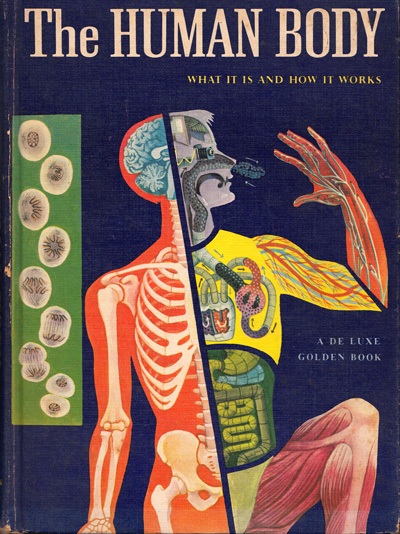 Much of our inquiry into what makes us human focuses on understanding consciousness, yet we spend the whole of our lives in our physical bodies. As a lover of anatomical art and vintage science illustration, I was instantly enamored with The Human Body: What It Is And How It Works
— a stunning vintage anatomy book, depicting and explaining in more
than 200 vibrant mid-century illustrations the inner works of the body.
Originally published in 1959, this colorful gem was inspired by German
artist and researcher Fritz Kahn, who in his 1926 classic Man as Industrial Palace
described the human body as “the highest performance machine in the
world” and used industrial metaphors to illustrate its remarkable
capacities.
Much of our inquiry into what makes us human focuses on understanding consciousness, yet we spend the whole of our lives in our physical bodies. As a lover of anatomical art and vintage science illustration, I was instantly enamored with The Human Body: What It Is And How It Works
— a stunning vintage anatomy book, depicting and explaining in more
than 200 vibrant mid-century illustrations the inner works of the body.
Originally published in 1959, this colorful gem was inspired by German
artist and researcher Fritz Kahn, who in his 1926 classic Man as Industrial Palace
described the human body as “the highest performance machine in the
world” and used industrial metaphors to illustrate its remarkable
capacities.
From the nine systems of the body — skeletal, muscle, nervous, digestive, respiratory, circulatory, lymphatic, endocrine, and reproductive — to the intricacies of the different organs and senses, the tantalizing tome demonstrates, in delightfully illustrated detail, just how magnificent our physical complexity is.
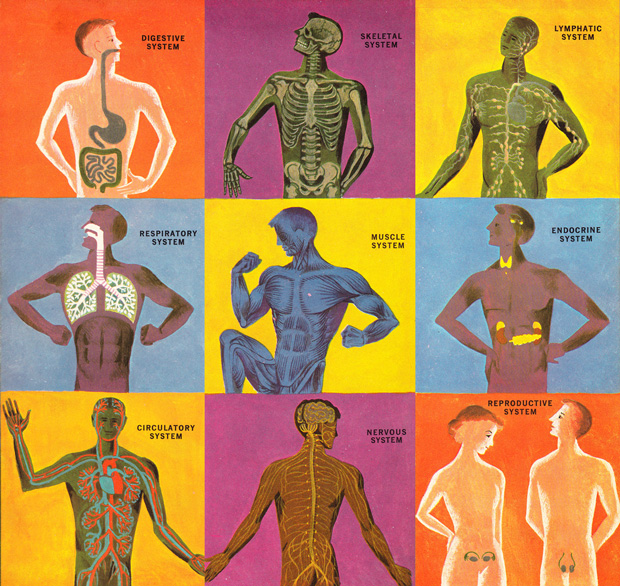
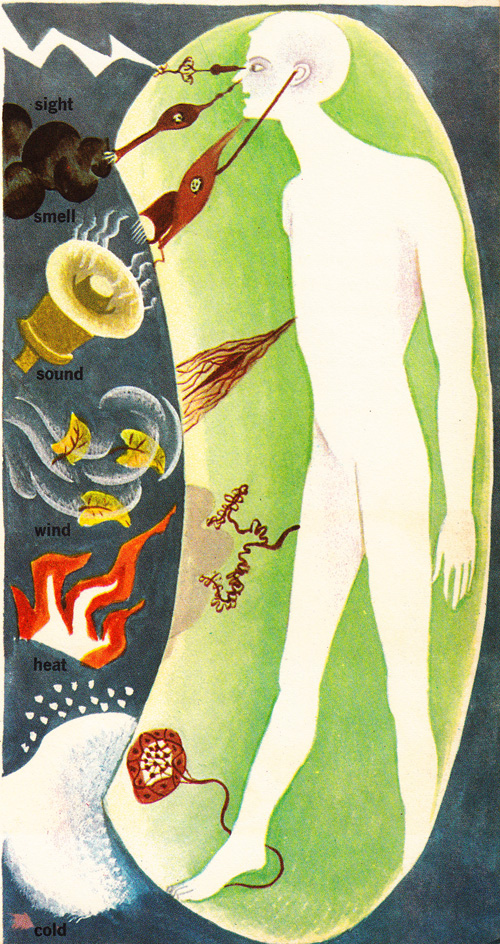

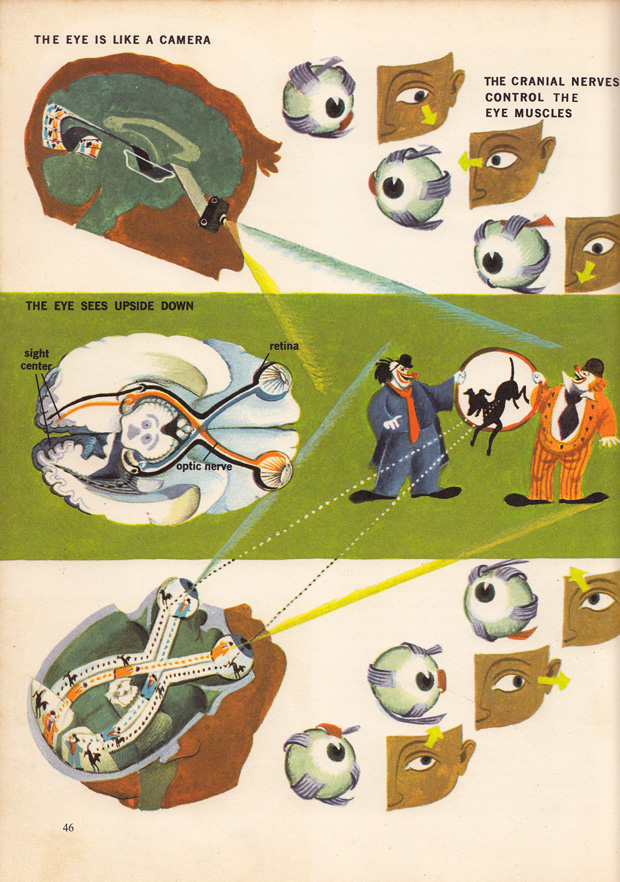
A gorgeous four-page centerfold illustrates full-body views of the various systems — muscles, blood vessels, nerves, digestive organs, and the gastrointestinal tract.

The introduction traces the history of our modern understanding of the body:
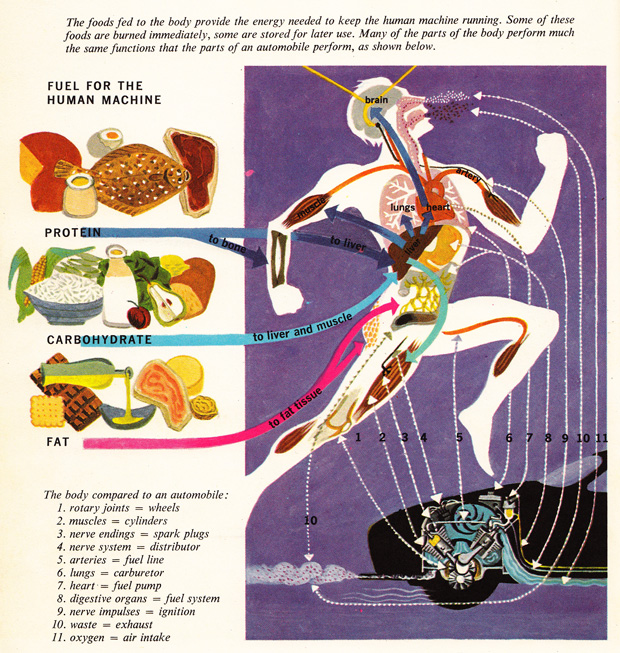
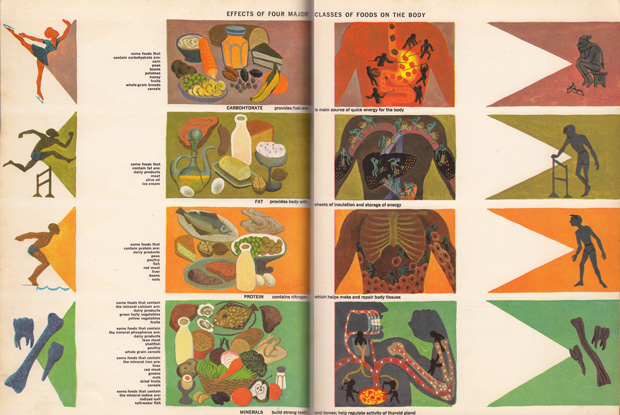
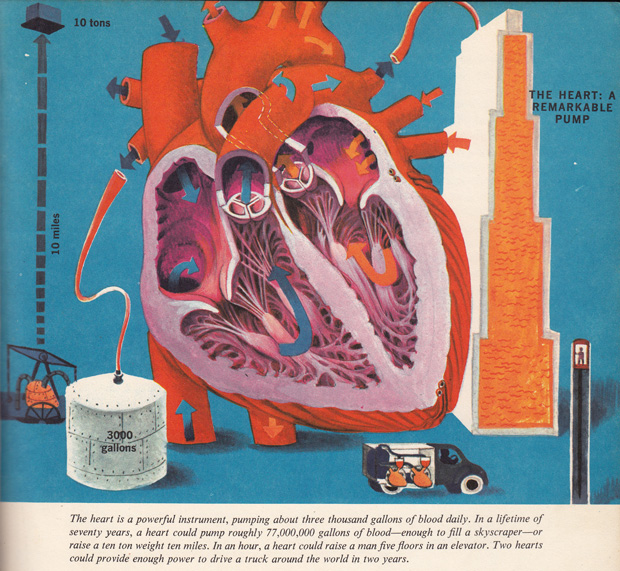
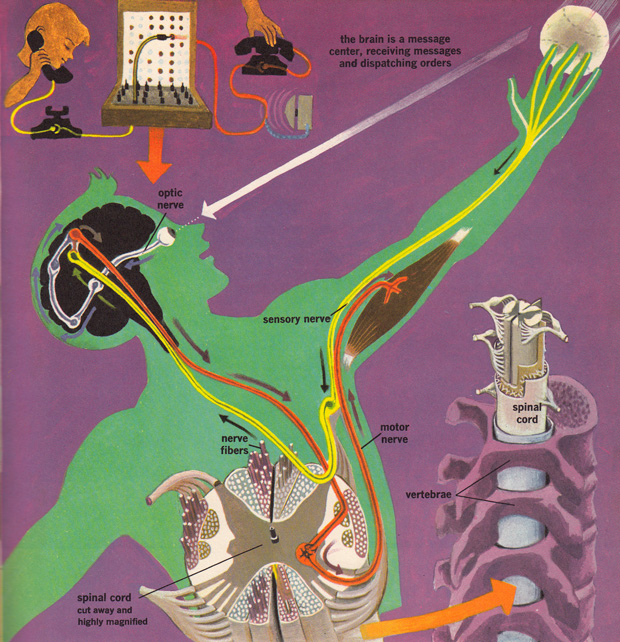
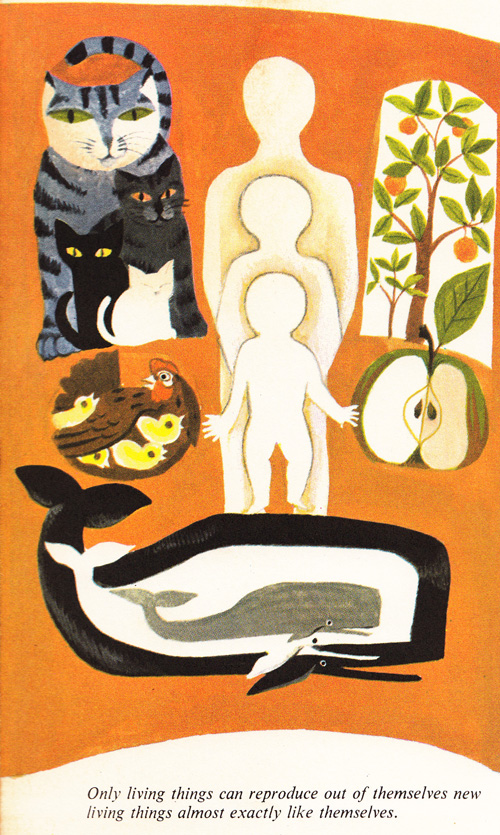
 Much of our inquiry into what makes us human focuses on understanding consciousness, yet we spend the whole of our lives in our physical bodies. As a lover of anatomical art and vintage science illustration, I was instantly enamored with The Human Body: What It Is And How It Works
— a stunning vintage anatomy book, depicting and explaining in more
than 200 vibrant mid-century illustrations the inner works of the body.
Originally published in 1959, this colorful gem was inspired by German
artist and researcher Fritz Kahn, who in his 1926 classic Man as Industrial Palace
described the human body as “the highest performance machine in the
world” and used industrial metaphors to illustrate its remarkable
capacities.
Much of our inquiry into what makes us human focuses on understanding consciousness, yet we spend the whole of our lives in our physical bodies. As a lover of anatomical art and vintage science illustration, I was instantly enamored with The Human Body: What It Is And How It Works
— a stunning vintage anatomy book, depicting and explaining in more
than 200 vibrant mid-century illustrations the inner works of the body.
Originally published in 1959, this colorful gem was inspired by German
artist and researcher Fritz Kahn, who in his 1926 classic Man as Industrial Palace
described the human body as “the highest performance machine in the
world” and used industrial metaphors to illustrate its remarkable
capacities.From the nine systems of the body — skeletal, muscle, nervous, digestive, respiratory, circulatory, lymphatic, endocrine, and reproductive — to the intricacies of the different organs and senses, the tantalizing tome demonstrates, in delightfully illustrated detail, just how magnificent our physical complexity is.




A gorgeous four-page centerfold illustrates full-body views of the various systems — muscles, blood vessels, nerves, digestive organs, and the gastrointestinal tract.

The introduction traces the history of our modern understanding of the body:
Almost nothing, it seems, could be more important to man than the human body. It is the solid part of “I”; it is with us as long as we live. Yet thousands and thousands of years passed before man really learned about this physical part of himself.
Among the ancients, health was something given by the gods. If you had an accident or got sick, it was because you had displeased the gods, or a demon had entered your body. The demon had to be eliminated, the gods made happy, before you could get well. Breathing and digestion, the circulation of blood, the working of the brain — these functions that kept a human being alive and active were not understood. The few real facts that were known were badly mixed up with superstition.





Wednesday, February 22, 2012
Thursday, February 16, 2012
Coconut Oil Touted as Alzheimer's Remedy
Researchers say the ketones found in coconut oil have slowed the progression of Alzheimer's disease in some people and may actually prevent it.
Subscribe to:
Comments (Atom)